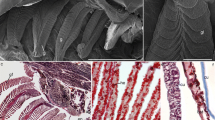Summary
Naupliar brine shrimp (Artemia salina) have been used to study the differentiation of salt secretory cells. The effects of several kinds of inhibitors on survival of nauplii at various salinities are presented. Results with ouabain indicate that the ability of the nauplii to survive at high salinities is dependent upon the presence of Na++K+-activated ATPase. Puromycin, chloramphenicol and cycloheximide, all inhibitors of protein synthesis, are more effective at high salt concentrations. Inhibitors of RNA synthesis that are primarily extranuclear in mechanism, i.e. rifamycin and ethidium bromide, also show a marked salt dependency. Among inhibitors which were assayed but did not effect survival under any circumstances were mitomycin C, 5-fluorodeoxyuridine and sarkomycin. Those inhibitors which did not show a differential salt sensitivity were actinomycin D and α-amanitin. It is concluded from these data that coincident transcription and translation of both nuclear and mitochondrial genes are involved in the development of the naupliar salt gland.
Similar content being viewed by others
References
Ashwell, M. A., Work, T. S.: Contrasting effects of cycloheximide on mitochondrial protein synthesisin vivo andin vitro. Biochem. biophys. Res. Commun.32, 1006–1012 (1968).
Ashwell, M. A., Work, T. S.: The biogenesis of mitochondria. Ann. Rev. Biochem.39, 251–290 (1970).
Conte, F. P.: The biochemical aspects of salt secretion. In: Hoar, W. S., and Randall, D. J. (eds.), Fish physiology, vol.1, p. 105–120. New York: Academic Press 1969.
Conte, P. P., Harris, P. J., Hootman, S. R.: Neck organ ofArtemia salina nauplii: A larval salt gland. J. Comp. Physiol.80, 239–246 (1972).
Finamore, F. J., Clegg, J. S.: Biochemical morphogenesis in the brine shrimp. In: Padilla, G. M., Whitson, G. L., and Cameron, I. L. (eds.), The cell cycle: Geneenzyme interactions, p. 249–278. New York: Academic Press 1969.
Gitler, C.: Personal communication.
Glynn, I. M.: The action of cardiac glycosides on sodium and potassium movements in human red cells. J. Physiol. (Lond.)136, 148–173 (1957).
Goldberg, I. H., Friedman, P. A.: Antibiotics and nucleic acids. Ann. Rev. Biochem.40, 775–810 (1971).
Hirschman, S. Z.: Inhibitors of DNA polymerases of murine leukemia viruses: Activity of ethidium bromide. Science173, 441–443 (1971).
Kedinger, C., Gniazdowski, M., Mandel, J. L.Jr., Gissinger, F., Chambon, P.: α-Amanitin: A specific inhibitor of one of two DNA-dependent RNA polymerase activities from calf thymus. Biochem. biophys. Res. Commun.38, 165–171 (1970).
Kroon, A. M.: Protein synthesis in heart mitochondria. I. Amino acid incorporation into the protein of isolated beef-heart mitochondria and fractions derived from them by sonic oscillation. Biochim. biophys. Acta (Amst.)72, 391–402 (1963).
Loeb, J. N., Hubby, B. G.: Amino acid incorporation by isolated mitochondria in the presence of cycloheximide. Biochim. biophys. Acta (Amst.)166, 745–747 (1968).
Maetz, J.: Mechanisms of salt and water transfer across membranes in teleosts in relation to the aquatic environment. In: Benson, G. K. (ed.), Hormones and the environment, p. 3–29. London: Cambridge University Press 1970.
Post, R. L., Merrit, C. R., Kinsolving, C. R., Albright, C. D.: Membrane adenosine triphosphatase as a participant in the active transport of sodium and potassium in the human erythroeyte. J. biol. Chem.235, 1796–1800 (1960).
Schatzmann, J. H.: Herzglykoside als Hemmstoffe für den activen Kalium- und Natrium-Transport durch die Erynthrocytenmembran. Helv. physiol. pharmacol. Acta11, 346–354 (1953).
Shmerling, Z. G.: The effect of rifamycin on RNA synthesis in the rat liver mitochondria. Biochem. biophys. Res. Commun.37, 965–969 (1969).
Whittam, R.: Potassium movements and ATP in human red cells. J. Physiol. (Lond.)140, 479–497 (1958).
Wolfe, A. D., Allison, R. G.: N-Heterocycles: Probes of ribosome stability and structure. Fed. Proc.30, 1204 (1971).
Woodford, V. R., Leegwater, N., Drance, S. M.: A comparative study of some carbonic anhydrase inhibitors. Canad. J. Biochem.39, 287–295 (1961).
Zylber, E., Vesco, C., Penman, S.: Selective inhibition of the synthesis of mitochondria-associated RNA by ethidium bromide. J. molec. Biol.44, 195–204 (1969).
Author information
Authors and Affiliations
Additional information
This research was supported by AEC grant RLO 2227-T13-3.
Rights and permissions
About this article
Cite this article
Ewing, R.D., Peterson, G.L. & Conte, F.P. Larval salt gland ofArtemia salina nauplii. J. Comp. Physiol. 80, 247–254 (1972). https://doi.org/10.1007/BF00694839
Received:
Issue Date:
DOI: https://doi.org/10.1007/BF00694839




